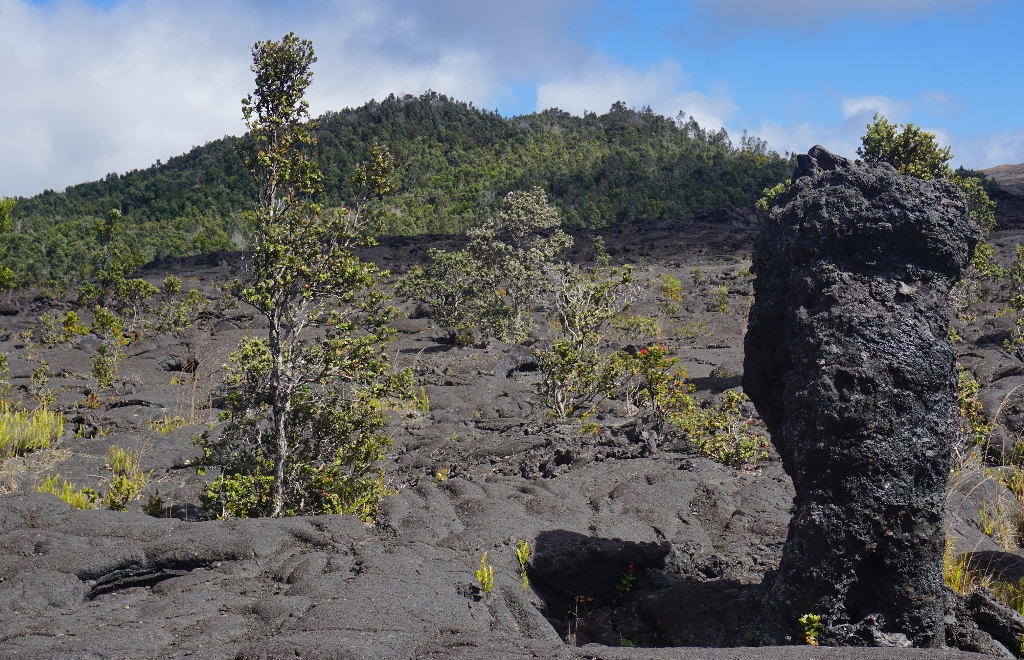
The forested hill to the left of Maunaulu is Pu‘uhuluhulu (shaggy hill), a volcanic cone that predates the new lava shield by over 500 years. Pu‘uhuluhulu is a pile of cinder, spatter, and ash that rained down from high, gascharged fountains. With no flows to carry away the ejecta, each fountain added to its height. Pu‘uhuluhulu stood nearly 300 feet (91 m) above the surrounding land when the eruption first began. By the time the eruption ended, this cone was dwarfed by its new neighbor, Maunaulu. If Maunaulu lava shield continued to erupt and grow, it may have completely surrounded and buried the older Pu‘uhuluhulu cone.
The crater inside this old cone protects rare native plants. Feral pigs ravage the nearby forests but can’t get into this crater, due to its steep inner walls. Treasures like ʻōhā—rare outside the crater—find sanctuary within its protective walls. Since the Maunaulu eruption, Puʻuhuluhulu has become an important source of life for new plants to become established on the fresh lava.
Pelehonuamea, a Hawaiian volcanic diety, is a force of both destruction and creation of the land. However it is the great Lono (god of vitality) and her sister Hiʻiakaikapoliopele (Hiʻiaka in the bosom of Pele) who bring new life to the barren flows.
The crater inside this old cone protects rare native plants. Feral pigs ravage the nearby forests but can’t get into this crater, due to its steep inner walls. Treasures like ʻōhā—rare outside the crater—find sanctuary within its protective walls. Since the Maunaulu eruption, Puʻuhuluhulu has become an important source of life for new plants to become established on the fresh lava.
Pelehonuamea, a Hawaiian volcanic diety, is a force of both destruction and creation of the land. However it is the great Lono (god of vitality) and her sister Hiʻiakaikapoliopele (Hiʻiaka in the bosom of Pele) who bring new life to the barren flows.
Is there something we missed for this itinerary?
Itineraries across USA

Acadia

Arches National Park

Badlands

Big Bend

Biscayne

Black Canyon Of The Gunnison

Bryce Canyon

Canyonlands

Capitol Reef

Carlsbad Caverns

Channel Islands

Congaree

Crater Lake

Cuyahoga Valley

Death Valley

Dry Tortugas

Everglades

Gateway Arch

Glacier

Grand Canyon

Grand Teton

Great Basin

Great Smoky Mountains

Guadalupe Mountains

Haleakalā

Hawaiʻi Volcanoes

Hot Springs

Indiana Dunes

Isle Royale

Joshua Tree

Kenai Fjords

Kobuk Valley

Lassen Volcanic

Mammoth Cave

Mesa Verde

Mount Rainier

North Cascades

Olympic

Petrified Forest

Pinnacles

Rocky Mountain

Saguaro

Shenandoah

Theodore Roosevelt

Virgin Islands

Voyageurs

White Sands

Wind Cave

Yellowstone

Yosemite

Zion